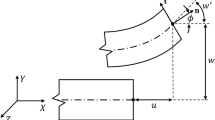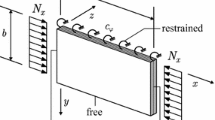Abstract
The coefficients of the first five terms of the crack tip asymptotic field of three-point bend single edge notched beams (TPBs) with span to depth ratios widely used in testing are computed using a hybrid crack element (HCE), which has the potential to directly calculate not only the stress intensity factor (SIF) but also the coefficients of the higher order terms of the crack tip asymptotic field. The general approximate closed-form expression for SIF proposed by Guinea et al. (1998) and the available numerical results for the second T-term are calibrated by the results of the HCE. Approximate analytical expressions for the second, third, fourth and fifth terms for a TPB with a span to depth ratio of 4 and for a single edge notched beam subjected to pure bending are obtained by fitting the computed data. These approximations are then used to predict the general expressions for coefficients of the higher order terms of a TPB with arbitrary span to depth ratio β. The accuracy of these general expressions is studied for TPBs with β=6, 8 and 12.
Similar content being viewed by others
REFERENCES
Du, Z.Z. and Hancock, J.W.(1991). The effect of non-singular stresses on crack tip constraint. Journal of the Mechanics and Physics of Solids 39, 555–567.
Guinea, G.V., Pastor, J.Y., Planas, J. and Elices, M. (1998). Stress intensity factor, compliance and CMOD for a general three-point-bend beam. International Journal of Fracture 89, 103–116.
Karihaloo, B.L.(1995). Fracture Mechanics and Structural Concrete. Addison Wesley Longman, UK.
Karihaloo, B.L.(1999). Size effect in shallow and deep notched quasi-brittle structures. International Journal of Fracture 95, 379–390.
Karihaloo, B.L. and Xiao, Q.Z. (2001). Accurate determination of the coefficients of elastic crack tip asymptotic field by a hybrid crack element with p-adaptivity. Engineering Fracture Mechanics 68, 1609–1630.
Karstensen, A.D., Nekkal, A. and Hancock, J.W.(1997). The constraint of elastic-plastic crack tip fields. Advances in Fracture Research, Proceeding of ICF9 (Edited by B.L. Karihaloo, Y.W. Mai, M.I. Ripley and R.O. Ritchie), Pergamon, Oxford, 2007–2014.
Leevers, P.S. and Radon, J.C. (1982). Inherent stress biaxiality in various fracture specimen geometries. International Journal of Fracture 19, 311–325.
Muskhelishvili, N.I. (1953). Some Basic Problems of Mathematical Theory of Elasticity. Noordhoff, Holland(English translation).
Nikishkov, G.P. (1998). A fracture concept based on the three-term elastic-plastic asymptotic expansion of the near-crack tip stress field. Fracture: a Topical Encyclopedia of Current Knowledge (Edited by G.P. Cherepanov), Malabar, Krieger Pub Co., Florida, 557–574.
O'Dowd, N.P. and Shih, C.F.(1991). Family of crack-tip fields characterized by a triaxiality parameter: Part I – Structure of fields. Journal of the Mechanics and Physics of Solids 39, 939–963.
Owen, D.R.J. and Fawkes, A.J. (1983). Engineering Fracture Mechanics: Numerical Methods and Applications. Pineridge Press Ltd., Swansea, UK.
Pian, T.H.H. and Sumihara, K. (1984). Rational approach for assumed stress finite elements. International Journal for Numerical Methods in Engineering 20, 1685–1695.
Pian, T.H.H. and Wu, C.C. (1988). A rational approach for choosing stress term of hybrid finite element formulations. International Journal for Numerical Methods in Engineering 26, 2331–2343.
Sham, T.L. (1991). The determination of the elastic T-term using higher order weight functions. International Journal of Fracture 48, 81–102.
Sih, G.C., Liebowitz, H. (1968). Mathematical theories of brittle fracture. In Fracture-An Advanced Treatise (Edited by H. Liebowitz), II, Academic Press, New York, 67–190.
Timoshenko, S.P. and Goodier, J.N. (1970). Theory of Elasticity (3rd edition), McGraw-Hill, New York.
Tong, P., Pian, T.H.H. and Lasry, S.J. (1973). A hybrid element approach to crack problems in plane elasticity. International Journal for Numerical Methods in Engineering 7, 297–308.
Williams, M.L. (1957). On the stress distribution at the base of a stationary crack. Journal of Applied Mechanics 24, 109–114.
Xiao, Q.Z., Karihaloo, B.L. and Williams, F.W. (1999). Application of penalty-equilibrium hybrid stress element method to crack problems. Engineering Fracture Mechanics 63, 1–22.
Author information
Authors and Affiliations
Rights and permissions
About this article
Cite this article
Karihaloo, B., Xiao, Q. Higher order terms of the crack tip asymptotic field for a notched three-point bend beam. International Journal of Fracture 112, 111–128 (2001). https://doi.org/10.1023/A:1013392324585
Issue Date:
DOI: https://doi.org/10.1023/A:1013392324585




